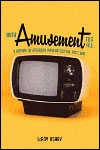book
With Amusement for All: A History of American Popular Culture since 1830
by LeRoy Ashby, Professor of History :: The University Press of Kentucky :: Reviewed by T.V. Reed

For many years, the study of popular culture, like comedian Rodney Dangerfield, "got no respect." Only with the vast amount of excellent, sophisticated research in the last three decades has the culture preferred by millions of Americans become serious history. LeRoy Ashby's With Amusement for All: A History of American Popular Culture Since 1830 is the first book to synthesize hundreds of recent studies of specific aspects of popular culture into a single, sweeping story. Both in time frame—from the 1830s, when innovations in communication and transportation first made a truly mass, national culture possible, to the present era of proliferating new media—and in scope—including circuses, wild west shows, vaudeville, magicians, musicals, stand-up comedy, rock, pop, rap, comic books, television, film, the Internet and much more—this is the kind of book that would be called encyclopedic, if it weren't such a witty and accessible read.
Ashby, a longtime professor of history at Washington State University, manages the immense scale of his story by building the book around several recurring themes that go a long way towards illuminating both the dynamics and the meanings of popular forms for U.S. cultural history. He notes, for example, a persistent pattern of popular cultural forms emerging from the margins of society—racial minorities, immigrants, women, economically lower classes—where the entertainments are originally shunned as crude, rude, or otherwise inappropriate, but then slowly adapted and adopted (for profit) by the mainstream. This process meant that popular culture was one key mode of upper mobility for many who had been beaten down by society. But such processes were also riddled with contradictions, as one marginalized group frequently gained respectability at the expense of others.
Blackface minstrelsy provides an apt example. Minstrelsy, in which white men would cover their faces with blackened cork to sing songs and tell tales in demeaning parody of African Americans, was the single most popular form of entertainment in 19th-century America. The source of vicious racial stereotyping that continues to this day, blackface was also a form used by the white working class to satirize bosses and the pretensions of the upper classes. It was also a route by which "not-yet-white" immigrants, especially, Irish Americans who had long been stereotyped in ways similar to those applied to African Americans, proved themselves "real" (i.e. white) Americans. In yet another twist, African Americans themselves were eventually drawn by economic necessity into "blackening up" as minstrels. Though caught in the web of a deeply racist form, many black performers managed to subtly undermine stereotypes and give humanity to the characters.
The class antagonisms visible in minstrelsy were pervasive throughout the 1800s, and without them we might never have had our modern form of Christmas. Christmas celebrations with a tree, gifts, and a family feast were, Ashby shows, started by nervous middle-class Americans who worried that the wilder forms of Christmas celebration among the working classes, especially carnivalesque near-riots in which the poor upturned social hierarchies and mocked the powerful, were in danger of overturning those hierarchies permanently. Christmas and minstrelsy were just two of many ways that class tensions were tamed, or were displaced onto racist forms that kept white workers in their place. Ashby shows how such patterns have persisted into the present, where debates about rap music, for example, are filled with questions pitting neo-stereotyping, sexism, homophobia, commercialism, and alleged immorality, against genuine elements of critique emerging from the underclasses.
With Amusement for All shows richly how much historical understanding we would have lost had elitist prejudice continued to limit academic study of popular entertainment.